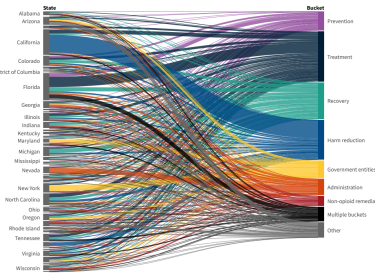
This Week's News in Substance Use: 6/1/18
Congress Is ‘Too Scared’ of the AMA to Really Attack Opioids , The Daily Beast
“Gary Mendell, CEO of Shatterproof—a nonprofit aimed at ‘ending the devastation addiction causes families’—said he has been told by congressional staff that ‘the AMA will resist anything that regulates health care’ on a number of issues.
“Mendell added that the AMA had also pushed against other opioid-safety related measures like federal grant money that required states to require their prescribers to check the Prescription Drug Monitoring Programs before they prescribed certain controlled substance medications and shared that information with other states. PDMPs help doctors analyze a patient’s prescription drug history prior to distributing additional medication and are mandatory in more than half of states, according to the Pew Charitable Trusts, but not regulated on the federal level.”
They Shared Drugs. Someone Died. Does That Make Them Killers? The New York Times
“As overdose deaths mount, prosecutors are increasingly treating them as homicide scenes and looking to hold someone criminally accountable. Using laws devised to go after drug dealers, they are charging friends, partners and siblings. The accused include young people who shared drugs at a party and a son who gave his mother heroin after her pain medication had been cut off. Many are fellow users, themselves struggling with addiction.
“Such cases are becoming more common even as the role of the criminal justice system in combating drug [misuse] has become hotly contested, and even as many prosecutors — including those who pursue overdose death cases — say they embrace the push to treat addiction as a public health crisis rather than a crime.”
Trump’s Anti-Drug PSAs Inspired by ‘This Is Your Brain on Drugs’ , New York Magazine
“Keith Humphreys, former senior policy adviser for the White House Office of National Drug Control Policy, told WBUR this week that the research on anti-drug ads says that they make no difference at all, except when they encourage drug use. ‘Occasionally at least some kids who see more of these ads actually say they’re more interested in trying drugs,’ he said. ‘That there’s something about the ads that either glamorize drugs to them or set off the young rebel in them.’
“One anti-drug campaign that did work succeeded because it veered away from the scare tactics. The ‘Above the Influence’ campaign, launched in 2005, saw moderate success by focusing not on drugs, but on the things teenagers could be doing instead of getting high. The ads also encouraged teens to be independent and autonomous by rejecting peer pressure.
The Trump administration appears to be returning to the stark tactics of the 1980s, and that could have seriously negative consequences. As Humphreys also told NPR last year, these types of ads give rebellious kids bad ideas: ‘It was a signal that, “Hey, you know, if you really want to irritate your elders, this is the way to do it.”’”
AP FACT CHECK: Trump’s Message on Opioids Is Too Optimistic , The Washington Post
“President Donald Trump is overstating progress against the opioid epidemic, claiming ‘the numbers are way down’ despite an increase of opioid-related deaths and overdoses in his first year in office.”
“A look at his comments during a political rally in Nashville, Tennessee, on Tuesday night:
“TRUMP: We got $6 billion for opioid and getting rid of that scourge that’s taking over our country. And the numbers are way down. We’re getting the word out — bad. Bad stuff. You go to the hospital, you have a broken arm, you come out, you’re a drug addict with this crap. It’s way down. We’re doing a good job with it. But we got $6 billion to help us with opioid.
“THE FACTS: Opioid prescriptions are down; deaths and other indicators of the epidemic are up, according to the latest statistics, from 2017. And those developments have nothing to do with the $6 billion approved by Congress because that money is for this year and next.”
Origins of an Epidemic: Purdue Pharma Knew Its Opioids Were Widely [Misused], The New York Times
“Purdue Pharma, the company that planted the seeds of the opioid epidemic through its aggressive marketing of OxyContin, has long claimed it was unaware of the powerful opioid painkiller’s growing [misuse] until years after it went on the market.
“But a copy of a confidential Justice Department report shows that federal prosecutors investigating the company found that Purdue Pharma knew about ‘significant’ [misuse] of OxyContin in the first years after the drug’s introduction in 1996 and concealed that information.
“Company officials had received reports that the pills were being crushed and snorted; stolen from pharmacies; and that some doctors were being charged with selling prescriptions, according to dozens of previously undisclosed documents that offer a detailed look inside Purdue Pharma. But the drug maker continued ‘in the face of this knowledge’ to market OxyContin as less prone to [misuse] and addiction than other prescription opioids, prosecutors wrote in 2006.”
The Heated Quest for Opioid Alternatives , The Wall Street Journal
“Rising [misuse] of prescription painkillers is intensifying a search for alternatives to addictive opioids.
“Overdoses of prescription opioids kill about 46 Americans a day, according to the Centers for Disease Control and Prevention. Despite that toll, opioids remain in widespread use because they are powerful painkillers, and many attempts to develop new therapies have failed.
“But drugmakers are exploring a growing number of potential alternatives and are conducting clinical trials of several painkillers designed to have little or no risk of [misuse] or addiction.”




